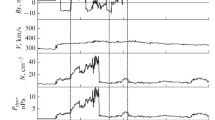Abstract
Using the minute data of the H component of geomagnetic field from the 20°E magnetic meridian chain and the 30°N magnetic latitudinal chain, the temporal evolution characteristics of the equatorial ring current during the storm on November 7–10, 2004 are studied. It is indicated that the UT-MLT and UT-MLAT graphics extremely exhibit the local time distribution, latitudinal variation and temporal evolution of the H component. The results show: (1) The UT-MLT contour clearly shows the increasing of the H component mostly around noon during the initial phase, representing the geomagnetic effect from the magnetopause current system. During the main phase, most negative values of the H component appear around the dusk-side, indicating the dawn-dusk asymmetric distribution of the ring current. (2) The contour of UT-MLAT suggests the latitudinal variation of the H component decreasing with the enhancement of the latitudes during geomagnetic storm, which is in good agreement with the D st index. The latitudinal variations provide a new sight for describing the temporal characteristics of the intensity of the storm-time ring current. (3) Both the contours of UT-MLT and UT-MLAT are useful to monitor the space-time distribution of the equatorial ring current.
Similar content being viewed by others
References
Gonzalez W D, Joselyn J A, Kamide Y, et al. What is a geomagnetic storms? J Geophys Res, 1994, 99(A4): 5771–5792
Chapman S, Bartels J. Geomagnetism. London: Oxford University Press, 1940
Jacobs J A. Geomagnetism. London: Oxford University Press, 1989
Akasofu S I, Chapman S. On the asymmetric development of magnetic storm fields in low and middle latitudes. Planet Space Sci, 1964, 12: 607–626
Cummings W D. Asymmetric ring currents and the low-latitude disturbance daily variation. J Geophys Res, 1966, 71: 4495–4503
Cooker N U, McPherron R L. On the distinction between the auroral electrojet and partial ring current systems. J Geophys Res, 1972, 77(34): 6886–6889
Akasofu S I. Solar-Terrestrial Physics. London: Oxford at the Clarend Press, 1972
Frank L A. Direct detection of asymmetric increases of extractterrestrial ring current proton intensities in the outer radiation zone. J Geophys Res, 1970, 75: 1263–1270
Smith P H, Hoffman R A. Ring current particle distributions during the magnetic storms of December 16–18. J Geophys Res, 1973, 78: 4731–4742
Rastogi R G, Winch D E, James M E. Longitudinal effects in geomagnetic disturbances at mid-latitudes. Earth Planets Space, 2001, 53: 969–979
Clauer C R. Solar wind control of the low-latitude asymmetric magnetic disturbance field. J Geophys Res, 1983, 83(A4): 2123–2130
Iyemori T. Storm-Time Magnetospheric Currents Inferred from Mid-Latitude Geomagnetic Field Variations. J Geomag Geoelectr, 1990, 42: 1249–1265
Grafe A, Bespalov P A, Trakhtengerts V Y, et al. Afternoon mid-latitude current system and low-latitude geomagnetic field asymmetry during geomagnetic storms. Ann Geophys, 1997, 15: 1537–1547
Huang C S, Foster J C, Goncharenko L P, et al. Variations of low-latitude geomagnetic fields and D st index caused by magnetospheric substorms. J Geophys Res, 2004, 109: A05219, doi: 10.1029/2003JA010334
Grafe A. Are our ideas about D st correct? Ann Geophys, 1999, 17: 1–10
Maltsev Y P. Points of Controversy in the study of Magnetic Storms. Space Sci Rev, 2004, 110(3–4): 227–267
Kawasaki K, Akasofu S I. Low-latitude DS component of geomagnetic storm field. J Geophys Res, 1971, 76: 2396–2405
Xu W Y. Effects of the magnetospheric currents on the S q field and a new magnetic index characterizing S q dynamo current intensity. J Geomag Geoelectr, 1992, 44(3): 449–458
Clauer C R, Mcpherron R L. Mapping the local time-universal time development of magnetospheric substorms using mid-latitude magnetic observations. J Geophys Res, 1974, 79: 2811–2820
Nakano S, Iyemori T. Storm-time field-aligned currents on the nightside inferred from ground-based magnetic data at midlatitudes: Relationships with the interplanetary magnetic field and substorms. J Geophys Res, 2005, 110: A07216, doi: 10.1029/2004JA010737
Shi Y, Zesta E, Lyons L R, et al. Effect of solar wind pressure enhancements on storm time ring current asymmetry. J Geophys Res, 2005, 110: A10205, doi: 10.1029/2005JA011019
Author information
Authors and Affiliations
Corresponding author
Additional information
Supported by the National Basic Research Program of China (Grant No. 2006CB806305) and National Natural Science Foundation of China (Grant No. 40436016)
Rights and permissions
About this article
Cite this article
Wu, Y., Xu, W., Chen, G. et al. Ground magnetic characteristics of the storm-time ring current Asymmetry. Sci. China Ser. D-Earth Sci. 51, 686–693 (2008). https://doi.org/10.1007/s11430-008-0045-0
Received:
Accepted:
Published:
Issue Date:
DOI: https://doi.org/10.1007/s11430-008-0045-0



